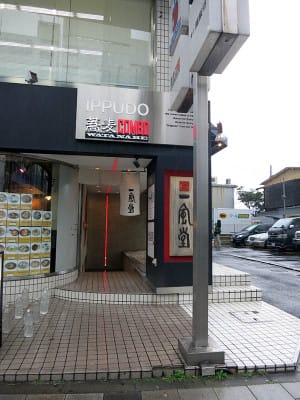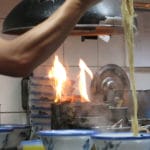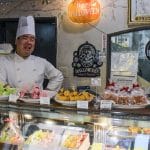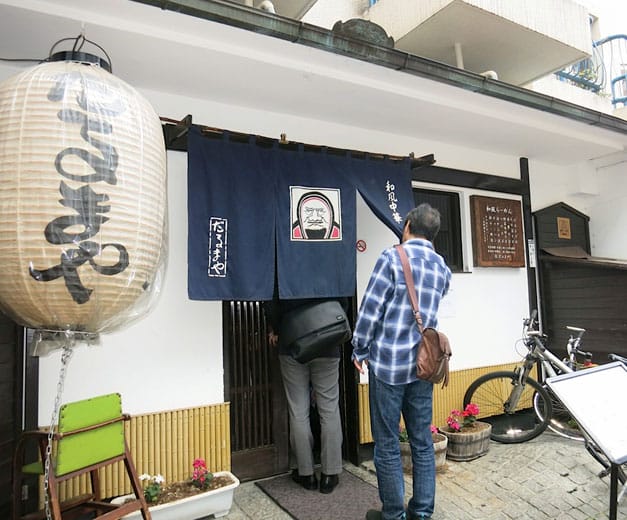We crept down an almost unmarked flight of stairs, then through a dim, winding corridor and finally pulled back a noren curtain to find ourselves in the world’s only Ippudo ramen location that serves soba noodles instead of ramen. As we seated ourselves on stools around the U-shaped counter, the aroma of tonkotsu (pork bone) broth reached our sinuses and informed us that we had arrived in a place like no other.
Shigemi Kawahara opened his first Ippudo ramen shop on the southern Japanese island of Kyushu in1985 and over the next 15 years became a revered ramen master by winning numerous ramen championships on TV. He then expanded his empire north to Tokyo and Osaka. In 2008, he went even further, opening the first Ippudo ramen in New York City, which contributed to the ramen craze that was then taking off the West. Today, his company has branches in at least a dozen countries around the world, primarily in Asia. Doting fans have made Ippudo wildly successful for its modern take on traditional ramen: It doesn’t matter the time of day or the weather; the lines of hungry people waiting for a bowl of Hakata-style, tonkotsu pork-based noodles are infamous. The line outside Ippudo on Tokyo’s Omotesando is no exception.
While Ippudo has developed a satisfying, no-holds barred, richly filling ramen, at Soba Combo Watanabe they put the Ippudo spin on soba noodles. The Watanabe Noodle Factory became a partner in Ippudo several years ago. Perhaps because the factory also makes soba, the Ippudo group decided to kick things up a notch, and opened Soba Combo Watanabe in 2013 – possibly as an experiment to see if this kind of soba would catch on. Soba Combo Watanabe is tucked into a side room off Ippudo’s ramen section and, since no other branches with this concept have yet been opened, so far it’s the only place to find these amazing noodles.
There are numerous styles of Japanese ramen, which are defined by the kind of broth, the texture of the noodles and the materials (vegetables and meat) included in the dish. Each region of Japan favors one or two styles particular to that part of the country. Tokyo favors a lighter broth, frequently chicken-based. Sapporo ramen, from the northern island, is richer, heavier and often laced with miso, as is appropriate for a cold climate. Hakata ramen, named after the Hakata district of Fukuoka on Kyushu where it originated, is brazenly pork-based. The tonkotsu broth is made using pork bones cooked at a rolling boil to create a rich, oily soup with pork fat glistening on top.
Ramen noodles are wheat-based and easily hold the flavors of the broth when pulled from the soup. Soba noodles contain varying combinations of wheat and buckwheat and are perhaps less appropriate for holding liquid flavors. To address that drawback, the Watanabe folks serve the soba noodles cold, to be dipped in a sauce on the side, as a cold tsuke (dipping) soba. The clever play here is that the dipping sauce is a hearty Ippudo ramen broth instead of the light dipping sauce usually served with soba.
Cooks behind the counter create each dish to order as cool jazz wafts over the room. The dipping sauce, made of Ippudo’s proprietary recipe of tonkotsu stock, shoyu (soy sauce) and mirin (a sweet rice wine for cooking, similar to sake but with more sugar and less alcohol, that’s a popular Japanese condiment), is heated and then blended while the soba noodles cook. The raw noodles have been cut by hand at the Watanabe factory. The chef weighs each portion to precisely 150 grams and ferries it over to the boiling water.  While some soba noodles are 100 percent buckwheat, at Soba Combo Watanabe the noodles are 40 percent buckwheat and 60 percent wheat, in order to keep the nutrients high (especially the antioxidant rutin found in buckwheat, which tends to break down during cooking without wheat). The cooked soba is immediately dunked into an ice water bath to bring it to room temperature and is then tossed for draining.
While some soba noodles are 100 percent buckwheat, at Soba Combo Watanabe the noodles are 40 percent buckwheat and 60 percent wheat, in order to keep the nutrients high (especially the antioxidant rutin found in buckwheat, which tends to break down during cooking without wheat). The cooked soba is immediately dunked into an ice water bath to bring it to room temperature and is then tossed for draining.
Soba Combo Watanabe currently serves five varieties of soba: plain, with fresh coriander, simmered Japanese beef intestines, roasted pork with scallions or what they call “spicy meats” (spicy pork). Customers are encouraged to customize their noodles or broth with any of the ingredients used in the dishes as a “topping.” Extra soba is available for the super-hungry, as are simple rice bowls with an egg or greens.
Our coriander soba arrived with a mound of the crunchy fresh herb and studded with nutty sesame seeds. Each bowl of dipping sauce is served with a house-made chicken ball for added protein. We swiped the noodles up and then through the tonkotsu dipping sauce. The first taste to hit the palate was the rich pork fat, quickly followed by a deep, grainy buckwheat flavor and the green freshness of the coriander. This is not how traditional soba has ever tasted. The chicken ball floating invitingly in the dipping sauce had soaked up the umami in the liquid and we cut into it with our chopsticks, finding it light and the perfect foil to the heartiness of the broth. We were glad that we’d ordered more chicken as a topping. A roasted pork and scallion soba came with slices of incredibly soft pork, thin white Japanese scallions and nori seaweed flaked on top.
A ramen place is not meant for lingering. As we savored our dishes, we watched a constant parade of people duck in, slurp up and move on. Soba Combo Watanabe is the kind of place you eagerly anticipate returning to again and again, if not to dawdle then to delight in a newfangled soba experience. The secret when you arrive is to tell the people at the door that you’re there for soba, and you can skip the ramen line!
 February 1, 2020 Afuri
February 1, 2020 Afuri
Once the province of late-night slurping at street carts or standup counters, instant […] Posted in Tokyo July 28, 2015 Daruma
July 28, 2015 Daruma
Almost 40 years ago Daruma opened its doors near Aoyama University, feeding the hungry […] Posted in Tokyo May 22, 2023 Ura Sablon
May 22, 2023 Ura Sablon
Ramen joints are often easily recognizable, either by large windows illuminating […] Posted in Tokyo
Published on February 29, 2016
Related stories
February 1, 2020
TokyoOnce the province of late-night slurping at street carts or standup counters, instant meals and cheap dining, ramen has undergone a renaissance over the last 18 years, making it onto haute hipster tasting menus in the West and creating punishing waits outside the “it” ramen-ya of Tokyo and Osaka. As the New Year began we…
July 28, 2015
TokyoAlmost 40 years ago Daruma opened its doors near Aoyama University, feeding the hungry students who flocked there, along with many neighbors and workers from the nearby office buildings. The prices were reasonable and the ramen was top class. Everyone came for the original recipe: Japanese-style ramen, with fresh house-made noodles and a pungently addictive…
May 22, 2023
TokyoRamen joints are often easily recognizable, either by large windows illuminating slurping customers, a vending machine dispensing meal tickets at the doorway, or the brightly lit signs; usually it’s some combination of the three. When it comes to Ura Sablon, however, one might easily pass it by. The narrow entrance is tucked away between a…


















































































